How to Enable or Disable Automatic Updates for Windows Update in Windows 10
Windows 10 will automatically check for new Windows Updates at the time you have set in automatic maintenance.
Windows 10 will automatically download and install important and critical updates by default
Some updates are not installed automatically. This includes optional updates and updates that require you to accept new terms of use. When these updates are available, Windows Update will let you know that they're ready to be installed.
Update: Microsoft updates Driver Shiproom Schedule for 2020 in Windows 10
This tutorial will show you how to enable or disable automatic updates in Windows Update for all users in Windows 10.
You must be signed in as an administrator to be able to enable or disable automatic updates.
Contents
- Option One: To Enable or Disable Automatic Updates using Wu10Man
- Option Two: To Enable or Disable Automatic Updates using Group Policy
- Option Three: To Enable or Disable Automatic Updates using a REG file
- Option Four: To Turn On or Off Automatic Device Driver Installation
- Option Five: To Enable or Disable Automatic Updates using Metered Network Connection
- Option Six: To Enable or Disable Automatic Updates by Enabling or Disabling Windows Update service
- Option Seven: To Enable or Disable Automatic Updates using WAU Manager
- Option Eight: To Enable or Disable Automatic Updates using StopUpdates10
EXAMPLE: Automatic Updates Disabled and Disabled by Group Policy for Windows Update
This option will work in all Windows 10 editions.
Win10Man is an open source tool by WereDev on GitHub that can be used to completely disable Windows Update in Windows 10.
If you disable automatic updates using Win10Man, you will need to enable Automatic Updates using Win10Man each time before you Check for and install updates in Windows Update.
1 Download and run the latest release of Win10Man at GitHub below.
2 Do step 3 (enable) or step 4 (disable) below for what you would like to do.
This is the default setting.
A) In the Group Policy tab, select Enable Automatic Updates (default) or Automatic Download, Notify of Installation in the drop menu for what you want, and click/tap on the Update Policy button. (see screenshots below)

B) In the Windows Services tab, turn on all Windows Services, and click/tap on OK after each one. (see screenshot below)
C) In the Hosts File tab, click/tap on the Unblock All Hosts button, and click/tap on OK. (see screenshots below)
D) You can now close Win10Man if you like.
A) In the Group Policy tab, select Disable Automatic Updates or Notify of Download and Installation in the drop menu for what you want, and click/tap on the Update Policy button. (see screenshots below)

B) In the Windows Services tab, turn off all Windows Services, and click/tap on OK after each one. (see screenshot below)
C) In the Hosts File tab, click/tap on the Block All Hosts button, and click/tap on OK. (see screenshots below)
D) You can now close Win10Man if you like.
This option is not available and will not work in Windows 10 Home. Microsoft has prevented disabling automatic updates in the Home edition.
This option will only work in the Windows 10 Pro and Enterprise editions.
This option does the same as Option Three below.
If you use this option and manually check for updates, then the updates will still always be automatically downloaded and installed.
If you let Windows automatically check for updates and notify you when updates are available, then this policy will let you disable automatic updates.
1 Open the Local Group Policy Editor.
2 In the left pane of Local Group Policy Editor, navigate to the location below. (see screenshot below)
Computer Configuration/Administrative Templates/Windows Components/Windows Update
3 In the right pane of Windows Update in Local Group Policy Editor, double click/tap on the Configure Automatic Updates policy to edit it. (see screenshot above)
4 Do step 5 (enable), step 6 (Notify), or step 7 (Never notify) below for what you would like to do.
This is the default setting.
A) Select (dot) Not Configured at the top, click/tap on OK, and go to step 8 below. (see screenshot below)
A) Select (dot) Enabled at the top. (see screenshot below)
B) Select 2. Notify for download and auto install or in the "Configure automatic updating" drop down menu under Options, click/tap on OK, and go to step 8 below.
A) Select (dot) Disabled at the top, click/tap on OK, and go to step 8 below. (see screenshot below)
8 When finished, close the Local Group Policy Editor.
9 Click/tap on the Check for updates button in Windows Update to apply.
10 Sometimes it may take a while for it to kick in to not automatically download and install updates though.
This option will not work in Windows 10 Home. Microsoft has prevented disabling automatic updates in the Home edition.
This option will only work in the Windows 10 Pro and Enterprise editions.
This option does the same as Option Two above.
If you use this option and manually check for updates, then the updates will still always be automatically downloaded and installed.
If you let Windows automatically check for updates and notify you when updates are available, then this policy will let you disable automatic updates.
1 Do step 2 (enable), step 3 (notify), step 4 (never notify) below for what you would like to do.
This is the default setting.
A) Click/tap on the Download button below to download the file below, and go to step 5 below.
Enable_Automatic_Updates.reg
Download
A) Click/tap on the Download button below to download the file below, and go to step 5 below.
Notify_before_Downloading_and_Installing_Updates.reg
Download
A) Click/tap on the Download button below to download the file below, and go to step 5 below.
Never_Notify_or_Check_for_Updates.reg
Download
5 Save the .reg file to your desktop.
6 Double click/tap on the downloaded .reg file to merge it.
7 When prompted, click/tap on Run, Yes (UAC), Yes, and OK to approve the merge.
8 Click/tap on the Check for updates button in Windows Update, then Restart the computer when finished to apply.
9 If you like, you can now delete the downloaded .reg file.
10 Sometimes it may take a while for it to kick in to not automatically download and install updates though.
Device Installation Settings allow you to change if Windows is to automatically download drivers and realistic icons for your devices from Windows Update.
This option will work in all Windows 10 editions.
Windows will automatically download and install updates, except on metered connections. In that case, Windows will automatically download only those updates required to keep Windows running smoothly.
This option will work in all Windows 10 editions.
1 To disable, set your wireless or Ethernet connection as metered.
How to Set Ethernet Connection as Metered or Non-Metered in Windows 10
OR
Set Wireless Network as Metered or Non-Metered Connection in Windows 10
2 Turn on (enable) or off (disable) to allow Download updates over metered connections (extra charge may apply).
If you disable the Windows Update service, Windows will no longer be able to automatically download and install updates.
When you are ready to download and install updates, you will need to enable and start the Windows Update service again, then check for updates.
This option will work in all Windows 10 editions.
Windows 10 is notorious about randomly automatically enabling the Windows Update service (even if disabled), so this option is not always reliable.
This option will work in all Windows 10 editions.
WAU Manager (Windows Automatic Updates Manager) is a fully featured replacement for the built in Windows Updating interface. This tool gives you full control of the Windows Updates, such as when and how they are installed, and has full uninstall and maintenance support for Windows updates.
WAU Manager was built to fully replace the built in Windows Automatic Updating (WAU) system. However, unlike the latter, WAU Manger puts you in control of everything. With WAU Manager you can:
1. Update manually when desired with just one click on a dedicated desktop shortcut
2. Update automatically with the desired frequency. Once a day, once a month or once a year, or whatever you decide.
3. You get to choose whether the available updates are automatically downloaded and installed or not.
4. Easily uninstall several updates at once.
Basically you just need to make a few adjustments from the Dashboard dialog box to set everything up the way you want. If you need more advanced options, such as uninstalling or hiding/unhiding updates, they are all available straight from the Setup interface. The available modules are all linked together by the application menu, always available at the top right corner of the application's interface.
WAU Manager does not use the built in WAU schedule. Instead, it has its own schedule which works regardless of whether WAU are enabled or not. In fact, for WAU Manager to work flawlessly, you should disable Windows Updates completely. You can do that in WAU Manager's Dashboard module.
Besides the Dashboard module, WAU Manager has four more modules:
- The Install updates module, which searches for available updates, and installs the desired ones. You can also hide updates from this module. Hidden updates are not displayed as available for install.
- The Uninstall Updates module, which lets you uninstall or hide updates that were previously installed.
- The Unhide Updates module, which lets you view hidden updates and unhide the desired ones.
- The View update history module, which displays the Windows Update history and lets you perform maintenance actions related to Windows Update.
1 Download and run the latest release of WAU Manager below.
Download
WAU Manager.exe is a standalone application that does not install on your computer.
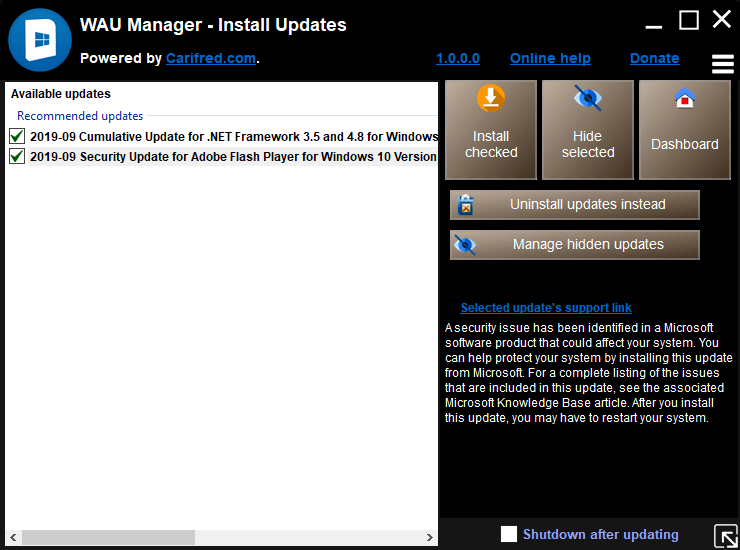

1 StopUpdates10 info.
Download
That's it,
Shawn Brink
Related Tutorials
- How to Check for and Install Windows Updates in Windows 10
- Enable or Disable Allow Automatically Download Updates over Metered Connections in Windows 10
- How to Enable or Disable Check for Windows Updates in Windows 10
- How to Hide or Show Windows Updates in Windows 10
- How to Change Automatic Maintenance Settings in Windows 10
- How to Enable or Disable Automatic Maintenance in Windows 10
- Choose How Windows and Store App Updates are Downloaded in Windows 10
- How to Specify How Windows and Store App Updates are Downloaded in Windows 10
- How to Turn On or Off Automatic Download and Install of App Updates by Store in Windows 10
- How to Turn On or Off Automatic Device Driver Installation in Windows 10
- How to Defer Feature and Quality Updates in Windows 10
- How to Reset Windows Update in Windows 10
- How to Change Active Hours for Windows Update in Windows 10
- How to Schedule a Restart Time for Windows Update in Windows 10
- How to Turn On or Off Show More Windows Update Restart Notifications in Windows 10
- How to Turn On or Off Give Updates for Other Microsoft Products in Windows 10
- How to Enable or Disable Including Driver Updates in Windows Update in Windows 10
- Turn On or Off Use sign in info to auto finish setting up device after update in Windows 10
- How to Turn On or Off Pause Updates in Windows 10
- How to Limit Bandwidth to Download and Upload Windows and App Updates in Windows 10
- How to See OS and Store Update Network Bandwidth Usage in Windows 10 Activity Monitor
- How to Specify Deadlines for Automatic Updates and Restarts in Windows 10
- Using CMD script and VBScript to control Windows Update
- How to Specify Target Feature Update Version in Windows 10
Enable or Disable Windows Update Automatic Updates in Windows 10
-
New #1
update: 2016 > Microsoft has disabled the Group Policy setting to stop updatesLast edited by nt62; 01 Dec 2016 at 14:12.
-
New #2
Hello nt62,
Sure, that's fine if that's what you wanted.
It's just recommended and safer to get a notification to let you know that you have updates available so that you don't forget or miss any that you may want to install. :)
-
New #3
hello,i did two options but they didn't work on build 10130. are there another ways to disable or customize updates?
-
New #4
Hello Alireza,
It should work for you after updating to the latest build 10166. :)
Announcing Windows 10 Insider Preview Build 10166
https://www.tenforums.com/tutorials/2...10-builds.html
-
New #5
How do you guys have an option to disable automatic Windows updates? I am using Windows 10 Pro x64, Build 10166. In Local Group Policy Editor, I don't have a "Disable" option, and that's what I was hoping to choose:
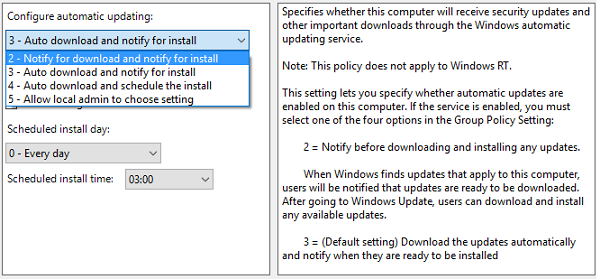
Just for kicks, I installed Windows 10 from scratch, and there was no change.
-
New #6
Hello jfreemont, and welcome to Ten Forums. :)
Alireza was referring to selecting Disabled instead of Enabled and number 2.
I would recommend to use the settings in the tutorial so that you will at least get a notification to let you know updates are available.
-
New #7
I run some kiosks where I don't want notifications or anything.
So you're saying that if I choose "Disabled" at the top, that will disable updates completely?
EDIT:
I just tried it and restarted the computer, but it doesn't seem to have worked...did I do it right? Settings still says "Automatic." It's not grayed-out like nt62's image shows.

-
New #8
If the status for this policy is set to Disabled, any updates that are available on Windows Update must be downloaded and installed manually. To do this, search for Windows Update using Start.Last edited by Brink; 10 Jul 2015 at 20:01.
-
-
New #9
I think I am confused.
nt62's image shows a picture of Windows Update with a grayed-out box that says "Never check for updates (not recommended)." Where did that come from?
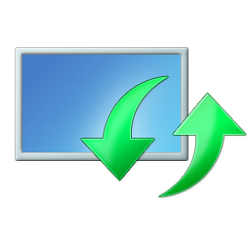
Enable or Disable Windows Update Automatic Updates in Windows 10
How to Enable or Disable Automatic Updates for Windows Update in Windows 10Published by Shawn BrinkCategory: Windows Update & Activation
17 Dec 2023
Tutorial Categories


Related Discussions


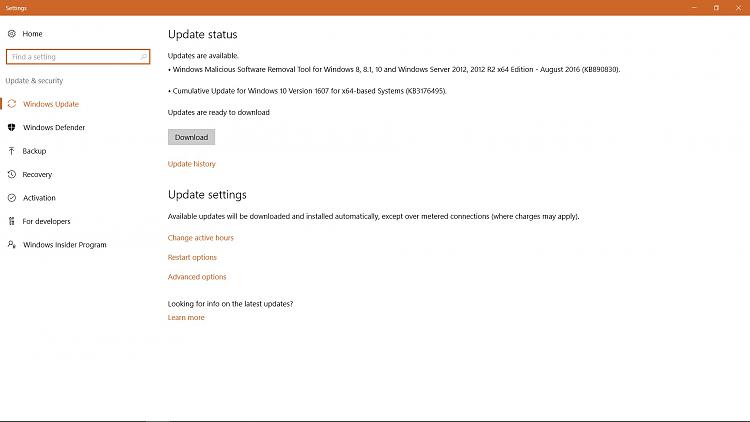


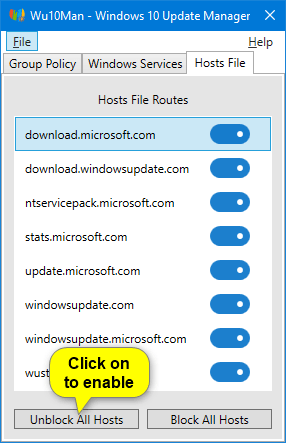


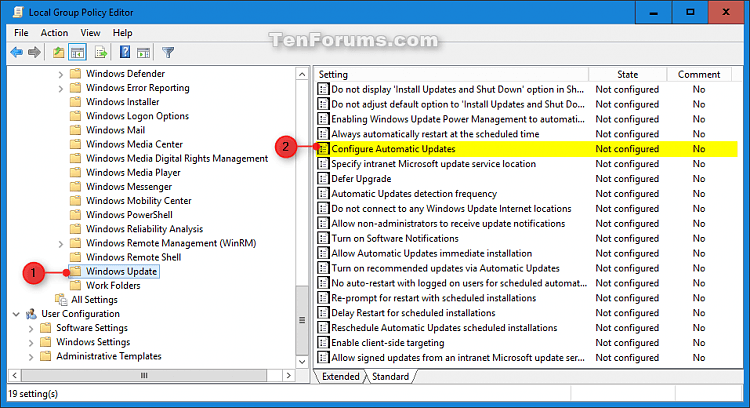
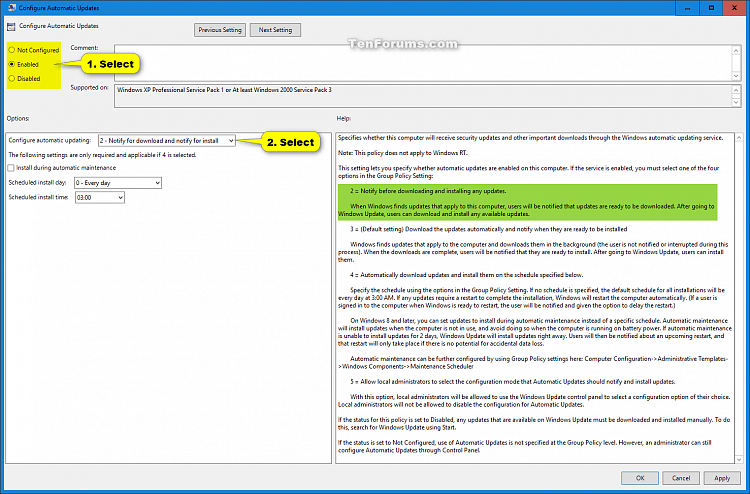


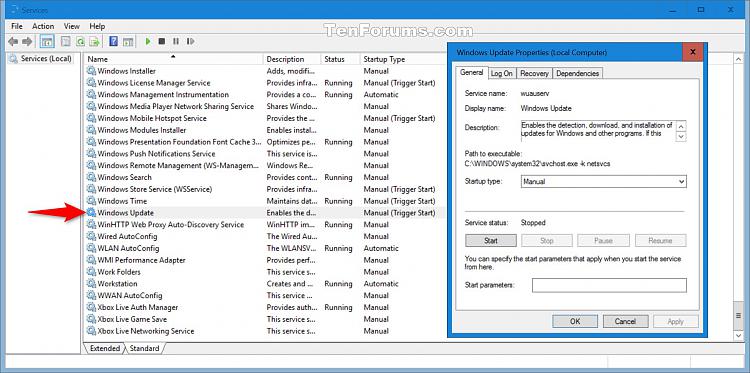




 Quote
Quote